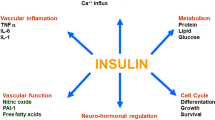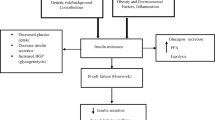Abstract
Objective Angiotensin II (Ang II), through the Ang II type 2 receptor (AT2R), may play some roles in the pathogenesis of glucose metabolism and diabetes mellitus (DM). The Adenine/Cytosine 3123 (A/C3123) polymorphism in the AT2R gene has reportedly been associated with metabolic conditions such as blood pressure and body mass index (BMI). The present cross-sectional study was aimed at investigating the association between the AT2R gene A/C3123 polymorphism and glycemic control parameters. Methods Among 286 community-dwelling Japanese subjects (men: women = 126:160; mean age, 65.1 years), AT2R A/C3123 polymorphism, which was detected by polymerase chain reaction methods, and metabolic parameters such as blood pressure, BMI, lipoprotein/lipid, insulin, and glycemic control parameters (fasting plasma glucose and HbA1c) were examined. Results In the whole study population, the proportion of C-allele was 67.0% and A-allele was 33.0%. The A-allele carriers had significantly lower HbA1c levels than the C/C-genotyped subjects in the group of women (5.5 ± 0.6 vs. 5.8 ± 1.5%, P = 0.042). The effect on HbA1c persisted to be significant with adjustments to age and BMI. In men, the associations between the polymorphism and glycemic control parameters were non-significantly noted. There were no differences between genotype-based groups in the other metabolic parameters in both sexes. Conclusion These results suggest that the AT2R A/C3123 polymorphism could be a polymorphic marker related to glycemic control, as presented in HbA1c, among general Japanese women.
Similar content being viewed by others
Abbreviations
- Ang II:
-
Angiotensin II
- DM:
-
Diabetes mellitus
- A/C:
-
Adenine/Cytosine
- BMI:
-
Body mass index
- RAS:
-
Renin-angiotensin system
- ACE:
-
Angiotensin-converting enzyme
- PG:
-
Plasma glucose
- FPG:
-
Fasting plasma glucose
- PPHG:
-
Postprandial hyperglycemia
References
King H, Aubert RE, Herman WH (1998) Global burden of diabetes, 1995–2025: prevalence, numerical estimates, and projections. Diabetes Care 21:1414–1431
Behn A, Ur E (2006) The obesity epidemic and its cardiovascular consequences. Curr Opin Cardiol 21:353–360
Furuhashi M, Ura N, Higashiura K, Murakami H, Tanaka M, Moniwa N et al (2003) Blockade of the renin-angiotensin system increases adiponectin concentrations in patients with essential hypertension. Hypertension 42:76–81
Scheen AJ (2004) Prevention of type 2 diabetes mellitus through inhibition of the renin-angiotensin system. Drugs 64:2537–2565
Furuhashi M, Ura N, Takizawa H, Yoshida D, Moniwa N, Murakami H et al (2004) Blockade of the renin-angiotensin system decreases adipocyte size with improvement in insulin sensitivity. J Hypertens 22:1977–1982
Kurtz TW, Pravenec M (2004) Antidiabetic mechanisms of angiotensin-converting enzyme inhibitors and angiotensin II receptor antagonists: beyond the renin-angiotensin system. J Hypertens 22:2253–2261
Scheen AJ (2004) Renin-angiotensin system inhibition prevents type 2 diabetes mellitus. Part 2. Overview of physiological and biochemical mechanisms. Diabete Metab 30:498–505
Jandeleit-Dahm KA, Tikellis C, Reid CM, Johnston CI, Cooper ME (2005) Why blockade of the renin-angiotensin system reduces the incidence of new-onset diabetes. J Hypertens 23:463–473
Gillespie EL, White CM, Kardas M, Lindberg M, Coleman CI (2005) The impact of ACE inhibitors or angiotensin II type 1 receptor blockers on the development of new-onset type 2 diabetes. Diabetes Care 28:2261–2266
Aksnes TA, Reims HM, Guptha S, Moan A, Os I, Kjeldsen SE (2006) Improved insulin sensitivity with the angiotensin II-receptor blocker losartan in patients with hypertension and other cardiovascular risk factors. J Hum Hypertens 20:860–866
Thomas GN, Tomlinson B, Chan JC, Sanderson JE, Cockram CS, Critchley JA (2001) Renin-angiotensin system gene polymorphisms, blood pressure, dyslipidemia, and diabetes in Hong Kong Chinese: a significant association of the ACE insertion/deletion polymorphism with type 2 diabetes. Diabetes Care 24:356–361
Strazzullo P, Iacone R, Iacoviello L, Russo O, Barba G, Russo P et al (2003) Genetic variation in the renin-angiotensin system and abdominal adiposity in men: the Olivetti Prospective Heart Study. Ann Intern Med 138:17–23
Yvan-Charvet L, Even P, Bloch-Faure M, Guerre-Millo M, Moustaid-Moussa N, Ferre P et al (2005) Deletion of the angiotensin type 2 receptor (AT2R) reduces adipose cell size and protects from diet-induced obesity and insulin resistance. Diabetes 54:991–999
Aoki S, Mukae S, Itoh S, Sato R, Nishio K, Iwata T et al (2001) The genetic factor in acute myocardial infarction with hypertension. Jpn Circ J 65:621–626
Kotani K, Sakane N, Saiga K, Tsuzaki K, Sano Y, Mu H et al (2007) The angiotensin II type 2 receptor gene polymorphism and body mass index in healthy Japanese women. Ann Clin Biochem 44:83–85
Aoki S, Mukae S, Itoh S, Sato R, Nishio K, Ueda H et al (2001) Genetic background in patients with acute myocardial infarction. Jpn Heart J 42:15–28
Lerman-Garber I, López-Ponce A, Murcio Flores RA, Brito-Córdova GX, Velasco-Pérez ML, Villa AR et al (2001) Comparing easy and accessible parameters of glycemic control in type 2 diabetes. Rev Invest Clin 53:518–525
Rosediani M, Azidah AK, Mafauzy M (2006) Correlation between fasting plasma glucose, post prandial glucose and glycated haemoglobin and fluctosamine. Med J Malaysia 61:67–71
Woerle HJ, Neumann C, Zschau S, Tenner S, Irsigler A, Schirra J et al (2007) Impact of fasting and postprandial glycemia on overall glycemic control in type 2 diabetes importance of postprandial glycemia to achieve target HbA1c levels. Diabetes Res Clin Pract 77:280–285
Guigliano D, Ceriello A, Esposito K (2008) Glucose metabolism and hyperglycemia. Am J Clin Nutr 87:S217–S222
Juan CC, Chien Y, Wu LY, Yang WM, Chang CL, Lai YH et al (2005) Angiotensin II enhances insulin sensitivity in vitro and in vivo. Endocrinology 146:2246–2254
Leung PS (2007) Mechanisms of protective effects induced by blockade of the renin-angiotensin system: novel role of the pancreatic islet angiotensin-generating system in Type 2 diabetes. Diabet Med 24:110–116
Faloia E, Camilloni MA, Giacchetti G, Mantero F (2000) Adipose tissue as an endocrine organ? A review of some recent data. Eat Weight Disord 5:116–123
Prins JB (2002) Adipose tissue as an endocrine organ. Best Pract Res Clin Endocrinol Metab 16:639–651
Giacchetti G, Sechi L, Rilli S, Carey RM (2005) The renin-angiotensin-aldosterone system, glucose metabolism and diabetes. Trends Endocrinol Metab 16:120–126
Wang JG, Staessen JA (2000) Genetic polymorphisms in the renin-angiotensin system: relevance for susceptibility to cardiovascular disease. Eur J Pharmacol 410:289–302
Acknowledgements
This study was supported in part by a Grant-in-Aid from the Foundation for the Development of the Community, Japan and by the Japanese Ministry of Education and Science Grant-in-Aid for Science Research (C), Japan.
Author information
Authors and Affiliations
Corresponding author
Rights and permissions
About this article
Cite this article
Kotani, K., Fujiwara, S., Tsuzaki, K. et al. An association between angiotensin II type 2 receptor gene A/C3123 polymorphism and glycemic control marker in a general Japanese population. Mol Biol Rep 36, 917–920 (2009). https://doi.org/10.1007/s11033-008-9263-y
Received:
Accepted:
Published:
Issue Date:
DOI: https://doi.org/10.1007/s11033-008-9263-y




